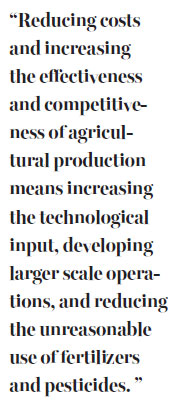Accelerate agricultural supply-side reform
Updated: 2016-02-05 08:06
By Song Hongyuan(China Daily Europe)
|
|||||||||
Increases in direct production costs are the major factor for the rising cost of agricultural production
Supply-side reform is the main theme of the No. 1 Central Document on agriculture this year. President Xi Jinping has reiterated that we should properly expand total demand, enhance structural reform of the supply side, increase the quality and efficiency of the supply system and strengthen sustainable economic growth impetus. The State Council, China's cabinet, also advanced cultivating new supply momentum to expand domestic demand.
The focus on supply-side reform shows the leadership's new understanding of China's macroeconomic policy and its emphasis in the future.
With supportive and preferential policies, China has made great achievements in agricultural and rural economic development. Crop production has increased for 12 consecutive years, and there's an abundant supply of major agricultural products. However, there are also many contradictions that need to be addressed.

On the one hand, China's agricultural products don't satisfy demand, which has resulted in a structural imbalance in the supply of agricultural products. For instance, the production, import and stock of crops have all increased recently. But while there is a basic balance between the production of and demand for wheat and rice, there has been a periodic oversupply of corn and a short supply of soybean in recent years.
Meanwhile, the amount and quality of arable land is declining, the underground water supply has been depleted and there is ever-increasing agricultural nonpoint source pollution.
Agricultural supply-side structural reform aims to comprehensively increase the supply of major agricultural products, focusing on the quality and the effectiveness of their supply rather than solely seeking production increases.
The key to accelerating agricultural supply-side reform is to improve the quality and efficiency of the supply of agricultural products to satisfy consumers' demands.
From now on the major agricultural policies will focus on destocking, reducing costs and making up for deficiencies.
Since 2012, the stock of China's three staple crops has greatly increased. Corn, in particular, faces great stock pressure. Too much crop storage not only puts pressure on the national finances, it also results in the failure of the whole grain industry chain. Eventually, this has a negative influence on food supply. Destocking aims to accelerate the processing and transforming of crops.

Meanwhile, increases in direct production costs are the major factor for the rising cost of agricultural production. Material costs such as fertilizer and pesticide, land rents and labor costs account for more than 80 percent of the overall agricultural production costs.
Due to the high production costs, many Chinese agricultural staple products lack international competitiveness. Reducing costs and increasing the effectiveness and competitiveness of agricultural production means increasing the technological input, developing larger scale operations, and reducing the unreasonable use of fertilizers and pesticides. Currently, the technological content and scale of China's agricultural production is still comparatively low. Making up for the deficiencies in agricultural production means enhancing the weak links in agricultural supply, such as agricultural infrastructure construction, and increasing the production of agricultural products that are wanted by consumers.
Several things need to be considered when promoting agricultural supply-side reform.
First, the government should play a better role in the process. The government should guide local sectors to make regional and differential policy according to their comparative advantages.
Second, the market should play the decisive role in the distribution of resources. The authorities should improve the market system to stimulate the market's vitality and increase the efficiency of resource distribution.
Third, agricultural supply-side reform is a process that cannot be accomplished at one stroke, and good preparation is needed for it to succeed.
The author is head of the Research Center for the Rural Economy at the Ministry of Agriculture. The views do not necessarily reflect those of China Daily.
Today's Top News
Inspectors to cover all of military
Britons embrace 'Super Thursday' elections
Campaign spreads Chinese cooking in the UK
Trump to aim all guns at Hillary Clinton
Labour set to take London after bitter campaign
Labour candidate favourite for London mayor
Fossil footprints bring dinosaurs to life
Buffett optimistic on China's economic transition
Hot Topics
Lunar probe , China growth forecasts, Emission rules get tougher, China seen through 'colored lens', International board,
Editor's Picks

|

|

|

|

|

|







